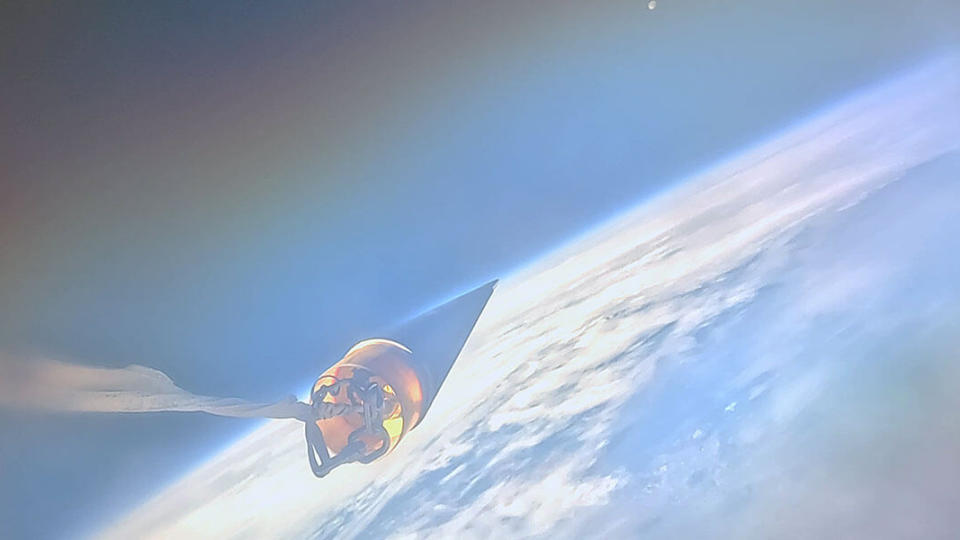When you buy through links on our articles, Future and its syndication partners may earn a commission.

Photo showing the nose cone of the USC Rocket Propulsion Lab’s Aftershock II rocket in space on Oct. 20, 2024. | Credit: USCRPL
The University of Southern California’s student rocketeers have done it again.
The USC Rocket Propulsion Lab (USCRPL) — which in 2019 became the first student organization ever to launch a rocket to space — sent its Aftershock II vehicle 470,400 feet (89.09 miles, or 143.38 kilometers) above Earth last month. That smashed the amateur altitude record of 380,000 feet (71.97 miles, or 115.82 km), which was set in 2004 by the Civilian Space Exploration Team.
Advertisement
Advertisement
“This achievement represents several engineering firsts,” Ryan Kraemer, the executive engineer of USCRPL and an undergrad majoring in mechanical engineering, said in a statement on Friday (Nov. 15). “Aftershock II is distinguished by the most powerful solid-propellant motor ever fired by students and the most powerful composite case motor made by amateurs.”

a dark, triangular rocket nose cone is seen in space above the curve of Earth
USCRPL’s groundbreaking April 2019 liftoff, from New Mexico’s Spaceport America, involved a rocket called Traveler IV. (Traveler is also the name of the horse ridden by USC’s Trojan mascot.) That vehicle reached a maximum altitude of 339,800 feet (64.4 miles, or 103.6 km) — above the 62-mile-high (100 km) Kármán Line, which many people view as the boundary of space — and a top speed of 3,386 mph (5,449 kph).
Related: USC students’ rocket reaches space in record-setting launch
Aftershock II’s landmark launch took place on Oct. 24 from the Black Rock Desert in Nevada. The 13-foot-tall (4 m), 330-pound (150 kilograms) rocket flew higher and faster than its predecessor, reaching a max speed of 3,602 mph (5,797 kph).
Advertisement
Advertisement
“This result establishes Aftershock II as the fastest and highest amateur rocket of all time,” the team wrote in a white paper verifying the flight data, which was posted on Thursday (Nov. 14).
The student team made this leap thanks to a new avionics unit and other important upgrades.
“To exceed the standard we set for ourselves with Traveler IV, we had to solve many technical and operational challenges,” Kraemer said.
“Thermal protection at hypersonic speeds is a major challenge at the industry level, and the protective paint system that we developed performed perfectly, enabling the rocket to return largely intact,” he added. “We also made an important upgrade to the fins, replacing the bare carbon edge of previous iterations with titanium leading edges. The titanium not only prevented fraying but actually turned blue from the intense heat during flight through anodization, which really demonstrates the extreme conditions our rocket successfully endured.”

seven people hold a small rocket in the back of a white pickup truck in the desert
RELATED STORIES:
Advertisement
Advertisement
— The Kármán Line: Where does space begin?
— Alabama high school students win world’s largest rocketry challenge
Aftershock II also featured custom computer systems and circuit boards, which the students designed and built from scratch, according to the Nov. 15 statement.
“This is an exceptionally ambitious project not only for a student team, but for any non-professional group of rocket engineers,” Dan Erwin, chair of the USC Department of Astronautical Engineering, said in the statement. “It’s a testament to the excellence we seek to develop in our emerging astronautical engineers, who go on to achieve top roles in the space industry and in government positions.”
EMEA Tribune is not involved in this news article, it is taken from our partners and or from the News Agencies. Copyright and Credit go to the News Agencies, email news@emeatribune.com Follow our WhatsApp verified Channel




